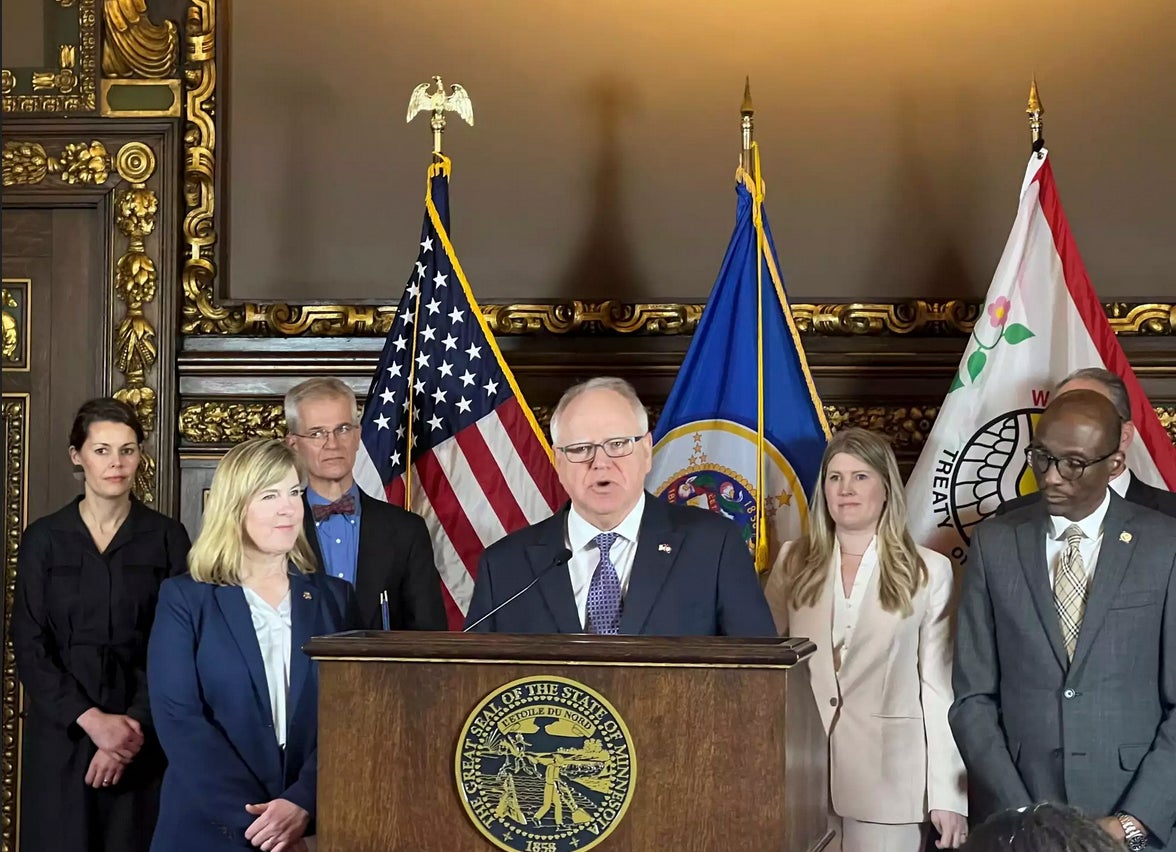Promising end to gridlock, DFL leaders agree on budget outline
Published 4:13 pm Tuesday, March 21, 2023

- Gov. Tim Walz, House Speaker Melissa Hortman, Senate President Bobby Joe Champion and other DFL lawmakers announced an agreement on Tuesday on broad budget numbers that set the stage for legislative work on a new two-year state budget. Brian Bakst/MPR News
|
Getting your Trinity Audio player ready...
|
By Brian Bakst and Dana Ferguson, Minnesota Public Radio News
Minnesota legislative leaders and the governor said Tuesday that they’d reached an agreement on the broad outlines of a new two-year state budget, including how to spend Minnesota’s historic surplus.
Gov. Tim Walz, House Speaker Melissa Hortman and Senate President Bobby Joe Champion – all DFLers – announced that the $17.8 billion surplus would fund increases to schools, housing initiatives and tax relief. The details will be worked out by legislative committees over the remaining weeks of the session.
Legislative leaders are required to make public their budget targets. But it’s rare that the leaders, along with the governor, would strike a deal on those numbers this early in the legislative session. Now, the outline moves to legislative committees to work out the details of how they’ll spend their part of the budget pie. The session must conclude by May 22.
“The era of gridlock is over,” Walz told reporters during a news conference Tuesday. “To come together on this speaks once again that government can work together for the people. We can reach compromises, we can get our work done on time, and we can deliver a budget that Minnesotans can be proud of.”
The biggest new spending tracked with many of DFL leaders’ priorities: they recommended putting $3 billion more toward pre-K through public schools and college aid, as well as another $1 billion for housing initiatives. And they earmarked $3 billion for tax cuts that they said could include direct rebate checks, tax credits, property tax relief and increases to local government aid.
Until the details are filled in, it’s impossible to say whether DFLers will pursue major tax increases to cover some of their tax relief and other spending. The initial Walz budget called for a new capital gains tax and some other tax and fee increases that were partially offset by tax cuts in other areas.
Hortman said the education bump is most significant to her.
“The things that I am most excited about in this budget is our historic investment in education from our littlest learners all the way through K-12 and through college,” she said.
The targets also include nearly $670 million to launch a paid family and medical leave program, which would be fueled by a new payroll tax once it is off the ground.
Leaders said their numbers include cash to pay for public works projects around the state after Senate Republicans last week withheld their support for a bonding bill that would have financed $1.5 billion worth of projects. GOP senators said they wanted to see Democrats move on tax cuts before they would vote for bonding. Such a bill needs a supermajority to pass, giving the minority party leverage over what’s in it and whether it passes
“There is not going to be hostage taking in negotiations, there is not going to be gridlock,” Walz said. “We are proposing $3 billion in tax cuts and it will be done. To tie the two together is something that I hear them rail about all the time as being unacceptable. That is exactly why you don’t have a bill.”
If Republicans support a bill funded by bond sales, it would free up cash in the DFL plan that presumably could be used for bigger tax cuts.
Republican lawmakers raised concerns about the outline, including the amount designated for tax relief.
“Only $5 billion of the $17.5 billion is ongoing money, but DFL Majority plans to spend it all,” Rep. Kristin Robbins, R-Maple Grove, said on Twitter. “$3 billion has been allocated to the Tax Committee, but that doesn’t mean we will see $3 billion in tax cuts — there are a lot of proposals for ‘spending’ through refundable credits.”


